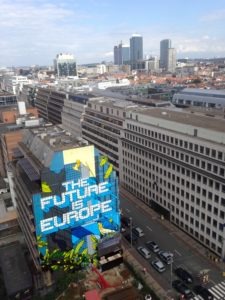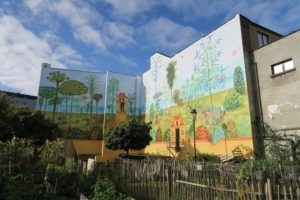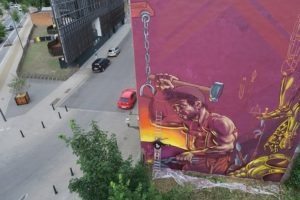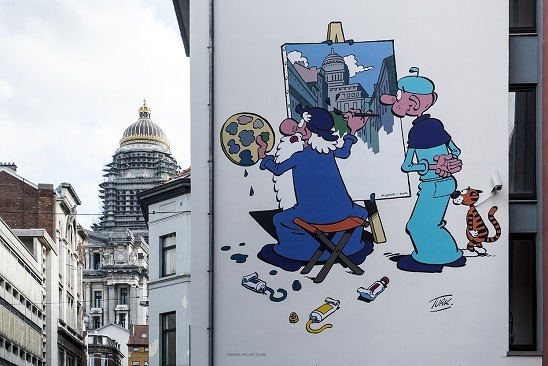As a city, Brussels is often defined by the glass and steel of its office buildings.
The European quarter, which appears in the background of many television news reports by foreign correspondents, is usually just a wall of windows, maybe bisected by a traffic-clogged boulevard. There is little room for colour or light.
Until recently, that is. In 2017, a splash of blues, whites and greens began brightening up a wall on the rue de la Loi. This is the road where the European Commission, the EU Council of Ministers and the Belgian Parliament all have their addresses. It is also a four-lane thoroughfare, and part of the backdrop seen in so many of those broadcasts. The image of a bird sat in the corner of the 530 m² mural, and a bold message ‘The Future Is Europe’.

Rue de la Loi 103, 1000 Bruxelles. Artist: Novadead. © Urbana
The mural was created by Urbana, a street art group that is working to brighten up the city’s bare surfaces. It has spread across Brussels, finding plain walls of buildings that are perhaps awaiting a neighbouring block, but in the meantime represent a blank canvas. The result has been a spray of colour and fun in the city.
Nico Morreel, who set up Urbana in 2012, says he was inspired by the murals he saw in other European cities, like Paris and Berlin. “I wanted to be on the same level as other cities. I wanted to promote Belgian artists. And I wanted Brussels to shine for the rest of the world,” he says.
Urbana’s offices are based near the Grand Place, above Morreel’s shop, Montana, which sells spray paint and other street art equipment, as well as books on street artists like Banksy. Brussels-born Morreel, 41, studied art at Le Septantecinq, the Woluwé art college, where he was drawn to graffiti.
Brussels authorities impressed
Urbana’s first three murals were installed at their own cost, after they asked permission from the owners of the buildings. One of the first, an abstract series of curvy, coloured shapes on boulevard Poincaré in Anderlecht, was by Brussels-born but Valencia-based Pablo Gonzalez, who signs his art as Sozyone. Another, an elephant behind coloured lights on rue Georges Leclercq in Forest, was by Steve Locatelli, one of Belgium’s street art stars, whose work can also be found in Ghent, and Antwerp, as well in the Netherlands, Germany, Sweden, Russia and New York.

Rue Georges Leclercq, 1190 Forest. Artist: Steve Locatelli. © Urbana
Morreel admits that he didn’t ask Brussels authorities before making the murals. “Normally, you need a permit to do this sort of thing, but we were worried that it would be turned down, or would take too much time to authorise,” he says.
Nonetheless, the Brussels authorities liked the results. They reached out and engaged with Urbana, as they developed street art-friendly policies. Brussels now has a Street Art Trail, with its own website. There are even apps to guide fans to murals. Other initiatives have been launched: last year, a former Delhaize supermarket in Ixelles was turned into a haven for street art called Strokar Inside – although an exhibition claiming to be by Banksy, was shut down in a copyright dispute.

“Oxygen”, the biggest mural in Brussels. Boulevard du Souverain 191, 1160 Auderghem. Artist: SozyOne Gonzalez. © Urbana
But it is Urbana that takes on the biggest commissions. “Nowadays, we do a mix,” Morreel says. “Sometimes we initiate projects, and we then seek funding. Sometimes, the Brussels authorities ask us. And sometimes artists ask us.” Morreel himself does not paint murals, but Urbana has two full time artists, with others attached during the ‘painting season’, from March to October.
Urbana does two types of projects. The first are their own initiatives: they manage the projects with selected artists, who then paint the walls themselves. Sometimes, the artists need help, as they have never done street art – or at least, never at the scale of the side of a building. Urbana can offer both equipment and assistance.

Mural based on a drawing by illustrator Brecht Evens. Located between rue du Char and rue du Grand Serment in Brussels. © Urbana
The other type of project is a reproduction of other people’s art, like comic strips. This includes the Comic Book Route (Parcours BD), begun by the City of Brussels in the early 90s. “When they commission us, we are executors,” Morreel says. “Our job is to reproduce as faithfully as possible. There is no room for interpretation.” Indeed, when they were commissioned to reproduce work by Belgian cartoonist Brecht Evens, they contacted the artist to seek permission to tweak the image as the hues of his original watercolours could not be replicated in the same way on a mural.
The relationship with the owners of the buildings is important: Urbana draws up contracts on what is allowed. “Of course, there are things you cannot do in the public space that you can do in private,” Morreel says. Owners have only a limited say in what is eventually put on the walls, “otherwise it is effectively a private commission from the owner,” he says.
Street art has transformed Brussels
Morreel says the first mural took just three days. “An artist will go faster as it is his work, and he can change it as he goes,” he says. For reproductions, it is more complicated. The contracts may say that they have to last for at least ten years, which means two, or sometimes even three layers. The mural of graphic novel warrior hero Thorgal, on place Anneessens, took four people 30 days to complete. The mural of the Smurfs, on a 200m2 ceiling next to the Central Station Hilton Hotel, took eight people two months.

Mural which depicts “Hephaistos”, the only Greek god with a physical handicap. Rue de la station, 1190 Forest. Artist: A Squid Called Sebastian. © Urbana
One of Urbana’s biggest projects was the “Giants of Anderlecht”, which involved 15 artists who were invited to decorate the pillars under the ringroad near the Neerpede ponds. Another major project, celebrating diversity, involved 40 Belgian artists who each decorated posters that were placed around a building site on rue Ravenstein.
Now that Morreel is involved in big art projects, what does he think of tagging – the wild graffiti sprayed on buildings – sometimes even on Urbana’s wall? “It’s like music: if you have a style like jazz-rock that doesn’t fit your musical code, then it sounds like noise,” he says. “I don’t hate it when people tag our work – I accept that it happens – but the best thing to do is to wash it off immediately.”
The merits of graffiti are disputed, but street art has clearly transformed Brussels, becoming part of the urban fabric and cheering the city up. Urbana itself has spread its wings across Belgium, notably with another Smurf mural, in Rochefort. But even a casual visitor to Brussels can see that there is lots of potential work in Brussels. “We have logged all the walls of central Brussels, the Pentagon: it is a huge work to map them and find owners,” he says. “Then we’ll move on to the other communes.”
By Leo Cendrowicz

